What Insulation is on your Terminal?
Posted by Pacer on 8th Jul 2019

*This Article was published on 7/08/2019 and was updated 11/02/2022*
Each type of terminal is built to handle a specific function and the same goes for the insulation that they carry. Just as ring terminals are vastly different from butt splices, so too is a nylon insulation different from an epoxy lined heat shrink insulation. There are a wide variety insulation types, so we will only focus on the most common types you are likely to run into. The main types of insulation that you are likely to encounter on a daily basis are; heat shrink, nylon, vinyl, and non-insulated. Ok, so the last one does not technically count as a type of insulation, but it is an important thing to discuss when considering the correct terminal for your project. So, let’s talk about that for a second. Just how important is selecting the right type of insulation for your terminals
Importance of Selecting the Correct Type
Now you may just think that any insulation on a terminal will do, right? Wrong. The type of insulation that a terminal carries greatly affects it’s; resistance to environmental hazards, resistance to corrosion, longevity, flexibility of the wire at the connection point, and a host of other potential factors. The fact is that each situation has different circumstances, and as such, may require a different type of insulation on the terminal. This is important as selecting the wrong type of insulation can leave your electrical system vulnerable. The wrong insulation can lead to a loss of conductivity or even electrical failure. This is why is it absolutely essential that you make sure you understand the differences between insulation types. This is a crucial factor when deciding which types of crimp connectors to use. Crimp connectors and other electrical connector types play a critical role in your electrical system.

Environmental Protection

Corrosion Resistant

Long Lasting Life Span
Varying Types of Insulation
As stated above, there are a wide variety of types of insulation, some of which are common and others that are much more obscure. We intend to focus this discussion on just the most common types you’re likely to run into. One of the most common types you are likely to see is heat shrink. These have become more popular in recent years for reasons we will discuss below. The other types you are most likely to encounter are nylon, vinyl, and non-insulated. Regardless of the insulation type, the electrical wire connectors you choose need to be of the highest quality. Electrical connectors determine, in some part, the quality of your electrical system. Below we will take an in depth look at each type of insulation as well as the types of terminals you’re going to find with that particular insulation type.
Heat Shrink
This is by far the most popular choice when it comes to terminal insulation, and for good reason. Not only does this type of insulation offer environmental protection from things like moisture and oil, but it protects your connection from corrosion as well. Well, that is assuming that you chose to use epoxy-lined heat shrink. You see, it’s that layer of epoxy that makes all the difference. The epoxy melts as the insulation is heated and coats the inside of the terminal as well as where the end of the terminal meets the wire insulation. This creates a solid, environmental seal that is designed to last long term. These are an essential choice when you are talking about a marine environment. Often, they are used in industrial applications where dust and contaminants are present.

Environmentally Resistant

Oil Resistant

Abrasion Resistant
Available Terminals
Heat shrink is available on multiple styles of wire connectors. As stated above, this is due in part to the high level of protection that they offer. Pacer offers heat shrink insulation on ring terminals, locking fork terminals, butt splices, step-down butt splices, bullet terminals, partially insulated disconnects, and fully insulated disconnects.
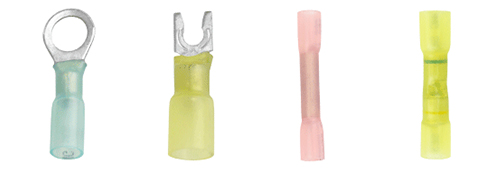
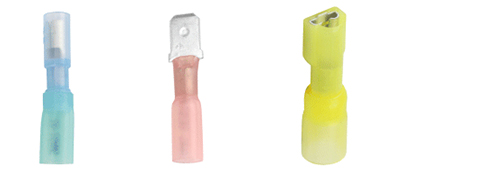
Nylon
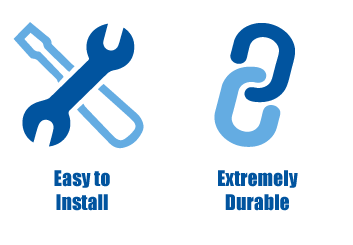
Nylon is definitely the first runner up, only being surpassed by epoxy lined heat shrink. Nylon is used in a variety of applications and settings such as; marine environments, the automotive industry, appliances, electrical equipment, and more. The reason this one is so popular is that it is simple to crimp and requires no additional effort on the part of the operator. As a matter of fact, nylon insulation is partially translucent making the job of inspecting a crimp a much simpler task. These are the kind of insulation used when people want the job done quickly but still need a high level of quality and the ability to inspect the crimp. Another benefit of this type of insulation is that nylon insulation is less expensive than epoxy lined heat shrink and is ideal for use when the environment is not a concern.
Available Terminals
Of all the terminal insulation's available, nylon seems to offer the widest variety of terminal type. This may be due to the fact that they offer a quick install time. Pacer offers nylon insulation on ring terminals, flanged fork terminals, locking fork terminals, butt splices, seamless barrel butt splices, brazed seam lugs, piggyback terminals, partially insulated disconnects, and fully insulated disconnects.
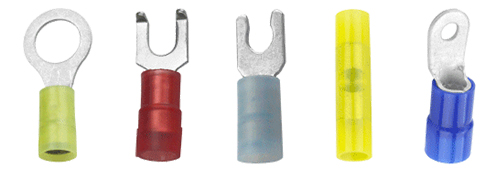
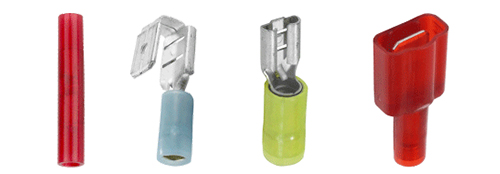
Vinyl
Next on our list is vinyl. This type of terminal insulation is useful in environments where moisture, oil, or other contaminants are not a concern. These are a great choice for use on internal wiring in a home or office where, often times, the electrical connections are between walls and not subject to vibration, flex, or any other type of hazard. They offer a decent level of abrasion resistance and even offer some impact resistance. This makes them suitable for industrial usage. Vinyl insulation is fairly common and found in use in the automotive industry, power management industry, recreational vehicle industry, and even the audio equipment industry. This is the go-to type of insulation when you are creating an electrical connection that may be subject to abrasion or minor impact, or in an environment where the electrical connection is secured for extended periods of time.

Impact Resistant

Range of Terminals

Abrasion Resistant
Available Terminals
Vinyl insulation can be found on some of the obscure types of terminals that are not available in other types of insulation. Pacer offers vinyl insulation on ring terminals, locking fork terminals, wire ferrules, butt splices, seamless barrel butt splices, pin terminals, piggyback terminals, and bullet terminals.
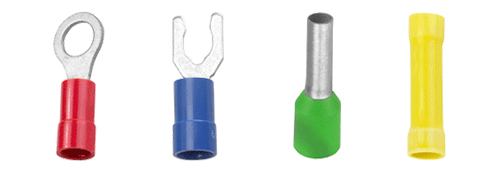
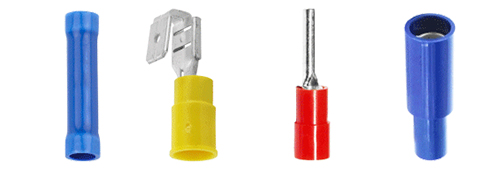
Non-Insulated
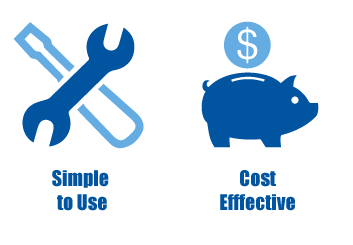
The last insulation type on our list is non-insulated. Now, as I said above, this technically isn’t a type of insulation, but bare terminals are still widely used today in a multitude of applications so it’s worth discussing. This type is the original. Before you had vinyl, or nylon, or heat shrink, you had bare terminals. These have lasted the test of time and are still favored by some. Non-insulated terminals offer protection from impact and abrasion and are built to last the long haul. To be honest, the reason people still use them is the fact that they are cost effective. Non-insulated terminals generally cost less than the other options we’ve discussed, but that is because they do not offer the same level of protection that you get from heat shrink, nylon, or vinyl insulation. The main benefit they offer is that inspection of the crimp, and in turn, the electrical connection, is much simpler than with the other types of insulation we’ve discussed.
Available Terminals
Non-insulated terminals are available in a range of styles most likely due to the fact that they are easy to install and inspect. Pacer offers non-insulated terminals such as ring terminals, locking fork terminals, step-down butt splices, seamless barrel butt splices, closed end lugs, brazed seam lugs, and piggyback terminals.
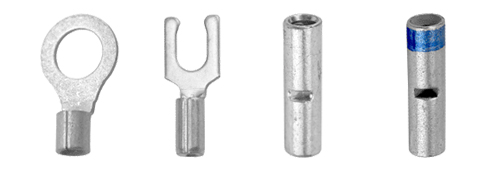
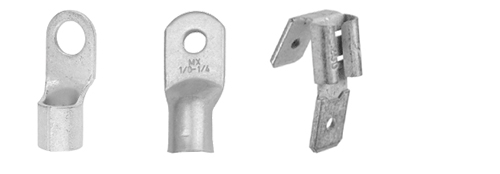
Importance of Choice.
We offer electrical solutions to our customers. Solutions come from finding what works best for you. By carrying a range of insulation types, we offer you the chance to build a custom solution. Sure, we could only carry nylon insulated terminals and nothing else, but maybe you need vinyl. Maybe you need heat shrink. The point is that by offering you choice, we’re not locking you into a single set of products. We’re giving you the freedom to make an educated decision based on your particular needs. If you have any questions about terminals, insulation types, or any other of our products, contact a Pacer expert today.
We have over forty years’ experience in the marine industry. In that time, we have refined, tested, and perfected our products and our product line. In this way, we have cultivated a catalog of the highest quality parts and tools you will find. We go as far as to use our products in our own boats. How else can you really understand how something works and what benefits it can offer. Over the last forty years, we have built a name around trust and reliability. In fact, some of the world’s largest boat builder’s turn to us for their electrical solutions. Think about that for a minute. Our brand is trusted by some of the biggest names in boating. That goes to show how much effort and care we put into our products. When you see Pacer on your parts, you know you’ve got quality.
